Night Key, The Black Castle, The Cllimax (1937, 1944)
Directed by: George Waggner, Lloyd Corrigan, Nathan Juran
Written by: Curt Siodmak, Edward Locke, George Waggner, Jack Moffat, Jerry Sackheim, Lynn Starling, William A. Pierce
Starring: Boris Karloff, J. Warren Hull, Jean Rogers, Richard Greene, Rita Corday, Turhan Bey
UNIVERSAL TERROR [1937, 1944, 1952]
AVAILABLE ON BLU-RAY: 18TH JULY, from EUREKA ENTERTAINMENT
Following on from their Karloff At Columbia set, our friends at Eureka Entertainment have unleashed more Boris Karloff, this time from Universal. Lets see if they make the grade.

DISC ONE
NIGHT KEY [1937]
RUNNING TIME: 67 mins
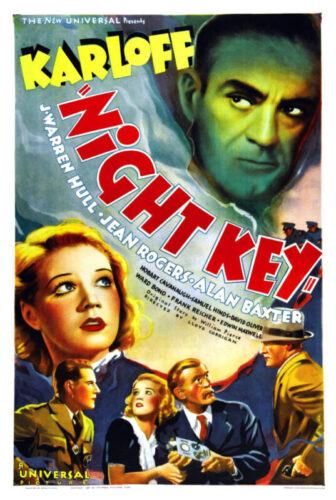 Twenty years ago inventor David Mallory made an advanced burglar alarm system, only for his partner Steven Ranger to swindle him out of all the credit and money that should have gone to Mallory, and all because the girl he loved married Mallory. Now, he’s created an even more advanced system, and hopes that he’ll be able to get the eye surgery he desperately needs as well as give his daughter Joan everything she wants. But, despite the aid of a lawyer who’s actually working for Ranger, Mallory is cheated again. So, with the aid of petty criminal Petty Louie, he sets out to embarrass Ranger by breaking into businesses that have his monitoring service, using another device of his which can override it. But then gangster Alan Baxter gets wind of what’s going on and feels that Mallory can assist him….
Twenty years ago inventor David Mallory made an advanced burglar alarm system, only for his partner Steven Ranger to swindle him out of all the credit and money that should have gone to Mallory, and all because the girl he loved married Mallory. Now, he’s created an even more advanced system, and hopes that he’ll be able to get the eye surgery he desperately needs as well as give his daughter Joan everything she wants. But, despite the aid of a lawyer who’s actually working for Ranger, Mallory is cheated again. So, with the aid of petty criminal Petty Louie, he sets out to embarrass Ranger by breaking into businesses that have his monitoring service, using another device of his which can override it. But then gangster Alan Baxter gets wind of what’s going on and feels that Mallory can assist him….
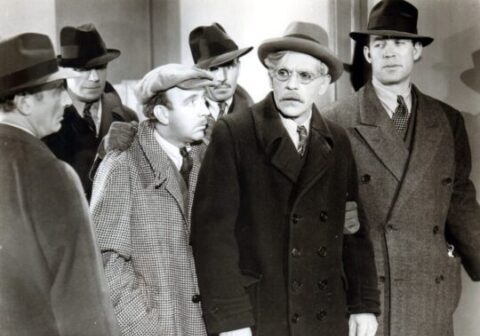
Probably the first thing that I ought to say about Night Key is that it’s not a horror film at all. One may therefore wonder why Eureka have chosen to include it in a set entitled Universal Terror, though in fact the company is only doing something that’s been done many times before, the film being erroneously packaged and marketed all the way back to 1954 when it was re-released in cinemas along with advertising that not just used images of Boris Karloff from The Climax [also included in this set], thereby making out that Karloff was playing a sinister character, but claimed that it featured “Death in the Wax Museum!” even though no wax museum appears. I wonder how many people attending these 1954 showings left auditoriums feeling disappointed and cheated, perhaps even before the film had finished? But let’s leave all that now and try to take the movie on its own terms, for what it is instead of for what it seems to promise to be. Like a couple of the Columbia Karloff Mad Doctor entries it can definitely be classed as science fiction, though none of what is invented in it seems impressive at all these days, reality having caught up with fantasy a fair amount of time ago. Night Key is a nifty little ‘B’ thriller, even if first-time filmmaker Lloyd Corrigan doesn’t quite give the exciting and eventful plot the push it needs, while the man himself, as always, makes it worth watching. In fact I’d say that this was one of his best performances of the second half of the ’30s, Karloff perfectly pulling off a role which doesn’t require him to be nasty or creepy at all, showing the range that he had which wasn’t allowed to be displayed as much as it could have been because he was associated with horror and villainy.
So New York is full of places which have had this system fitted, one which, when somebody goes inside, sends a signal back to the switchboard so that a light comes on and the operator can then call the police, meaning that a great many criminals have been caught who may not otherwise have been. It’s easy to laugh today, but way back in 1937 such an idea was fantastical. We open with a salesman installing a system to a stereotypically loud and arguing Italian couple; the husband is concerned that he will see dead bodies because intruders will be electrocuted. It’s the day of the twentieth anniversary since the Ranger Protection Service came into being, and Ranger the boss wants the rights to a new light-beam wireless security system from Mallory, who’s invented this new contraption that if you walk between two points, it breaks a beam of light and signals the alarm, though he almost didn’t finish it because he’s going blind. Mallory thinks that Ranger will be buying the device to use it, replacing his old system. However, Ranger and Mallory’s lawyer Mike Callahan are conspiring to rip the old man off. They sign the papers, but then, to staged outrage from Callahan, Ranger explains that the agreement made no specification as to when he will use the system, and he doesn’t intend to use it at all, instead having bought the device to bury it, not replace his old system. We feel for Mallory, introduced in a scene with his daughter Joan which is full of warmth and immediately makes us feel much sympathy for them. But hang on! Ranger stole the patent rights of the current system from Mallory twenty years ago, so why on earth would Mallory get involved another deal with him concerning his new system? Alright, he’s got this lawyer now, but it’s still very hard to believe. In fact, why on earth is he still partners with this guy?
“You WILL put in my system,” Mallory says, “because what I created, I can destroy,” as he holds up the short circuiting “key” that Ranger doesn’t know about. Mallory fiddles with it, and all the doors in the basement unlock, releasing Petty Louie, an incompetent crook caught breaking into the place, from confinement there. On the wall of the cell is scrawled “What I create, I can destroy” signed “Night Key.” Mallory’s already had enough of Louie, and no wonder, because he’s rather annoying the way he rabbits on in a supposedly funny but actually rather unfunny fashion; this kind of wisecracking needs actual jokes, though others make some okay ones at his expense. But Mallory almost gets ran over and his glasses certainly get ran over, so Louie helps him home and the two become a team, breaking and entering into places using Mallory’s “key”, then leaving messages. Louie wants to actually rob, but Mallory won’t hear of it; his goal is humiliating Ranger. The press makes a big deal out of the Night Key, and real gangsters take note. “A guy with a talent like that should be working for me,” says The Kid, but will Mallory play ball? Of course there’s also romance involving Joan and Jim Travers, one of Ranger’s security guards. Looking for her father, he sits outside her apartment for ages, then follows her all over the place for two whole days. Such stalking just makes her bend, as it often does in vintage movies, even though Warren Hull wears more eye makeup than Jean Rogers, who I’d only just watched a few days ago in the first of the Flash Gordon serials. The suspense revolves around Mallory; not just when will he escape or find a way to fight back, but also when will be go mad or turn nasty, because this is Karloff. But he never does go mad or turn funny, even though we’d probably be on his side if he did.
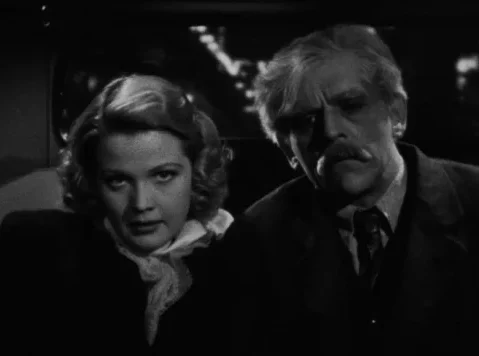
The screenplay by Tristram Tupper and Jack Moffit, from a story by William A. Pierce, seems to run out of ideas, but it does have two notable conceits. At one point, Louie scrawls a note on a table, “Send police to ABC Delivery Company,” without being seen, hoping that Travers, who should be along soon, will see it, but when he comes in the waitress has erased everything but “ABC DE,” which he has to work out for himself. And a major confrontation between two characters doesn’t happen, with instead a frankly ludicrous change of heart. Yet the cramming in of various elements certainly makes for a sometimes unpredictable piece, and it all moves at a fast pace, positively rushing through a few portions, even if the tension could be higher. The gangsters include a formidable Ward Bond who gives the impression that he’s going to do something nasty though never does. They seem ridiculously easily defeated, running away at the sight of the cops, while Alan Baxter as The Kid speaks in a dull monotone – yet does have a screen presence, and generally the acting in this film is pretty good. Even though Louie is a nuisance, we do care about whether he’ll either find real goodness or never escape his old ways. An escape sequence with animated electricity being employed to quite convincing effect is probably the best bit of the film, and it’s also a scene where you may almost want to cheer. As for the Night Key itself, we never really see it used for its intended purpose, though it does somehow disable a car.
There’s one shot where we adopt the blurry point of view of Mallory’s eyes as he’s just put his glasses on and his daughter comes into focus, and there’s some neat cutting when people finish other people’s lines, though for the most part look and style is quite run of the mill. Look out for a tiny bit of Frankenstein equipment. Now then, is there any doubt now that Karloff was easily the best actor out of the early wave of horror stars? Karloff sells his extremely naive character, and his version of an old man shuffling around in a frequent state of bewilderment is right on – just check out his body language and all. His voice and manner of speaking, usually made to sound so sinister, here exude sweetness and innocence. The bad guys only knock Mallory about once or twice, but we hate to see him being treated in this way and wonder if just one fall may kill him. He does seem rather too elderly to be Jean Rogers’s father though; perhaps they should have written her as his granddaughter. Was Mallory the first screen mad scientist to have a pretty daughter? The music score, made up entirely of second hand cues, opens oddly with a very out of place sounding piece evoking charm and sophistication, a strange choice indeed. The others, one of which will be very familiar to Universal horror lovers, work okay. Night Key is a very minor work, certainly interesting enough to keep one involved if never raising to another level, but is a fine showcase for its star. In that respect, Eureka were right to include it.
Rating: 









SPECIAL FEATURES
1080p presentation from a 2K scan of fine grain film elements
How great this restoration looks considering the age of the film. Eureka have probably used Scream Factory’s version and given it a new encode. Some shots in the final third are grainier than the rest of the film, yet it’s still well managed with no clustering. Black levels are strong and there’s only extremely minor print damage.
Brand new audio commentary with Kevin Lyons and Jonathan Rigby
These terrific audio commentaries are becoming as important a part of the fun of these releases as the films. Lyons and Rigby clearly like the film much more than I do, even the humour. I appreciated it a bit more by the end and we get a lot of production into too; this was a much delayed project which had constant rewrites even during shooting. We also learn that it was based on a real company, though Rigby understandably finds it odd that it shows the inner workings of an alarm system, while Lyons says how inaccurate it was that Karloff was associated with heavy makeup. The story is placed into its Depression contest and we even get some reviews of the time read out. Bristle when one snobby writeup says the film will be good for the “industrial element”. Such vile snobbery was sadly commonplace in reviews back in the day.
Trailer
Stills Galleries
THE CLIMAX [1944]
RUNNING TIME: 81 mins

Ten years ago, Dr. Hohner was in love with opera star Marcellina but was jealous of her voice, which he saw as coming between them. When she rejected his love, he killed her. Now, Hohner is the resident doctor at the opera house. He hears the voice of promising singer Angela which is almost identical to Marcellina’s. Impresario Count Seebruck hears her and plans to present her in the theater much to the dismay of resident soprano Jarmila Vadek. The lady is an instant success, but Hohner has other plans for her….
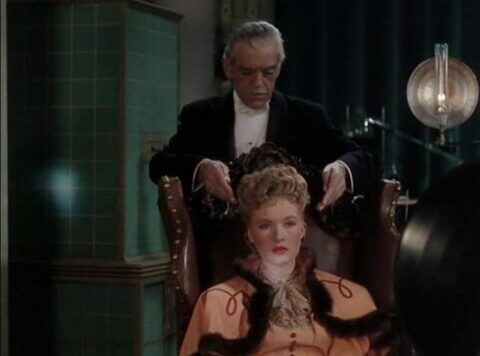
The Climax was probably the film I wanted to see most out of the three in this set, largely because I adore The Phantom Of The Opera – and yes, that includes the musical. It began life as a sequel to Universal’s 1943 adaptation which starred Claude Rains. While certainly nowhere near as good as the very first version, also made by Universal, from1926 with Lon Chaney, it was still a decent picture that went down some different pathways, including presenting a Phantom who was originally a normal-looking guy who had his music stolen and used, a premise that was employed in several later versions. It was also a rare Universal horror which was in colour, not to mention a huge commercial success. So Universal decided to reuse some of its sets [the main opera house interior of which was recycled from the 1926 version] and make a sequel, though only Susanna Foster and Jane Farrar came on board, and eventually it metamorphised into a standalone tale which is basically a variation of The Phantom Of The Opera melded with Svengali in reverse. That’s fair enough, but what’s truly odd is the approach. The 1943 film was often criticised for having too much opera and not enough phantom, yet The Climax is much the same. Yes, Karloff is often present on screen in his first colour appearance, but he does very little, and the film seems to go out of its way to avoid becoming horror. The result is a rather stuffy, static piece, where even the romantic side of things is very muted and the important music aspect is generally mediocre, everything dwarfed by the lavish sets and costumes. Yet it’s a beautiful film to look at, the premise does compel and Karloff as always is compulsively watchable, even if he doesn’t seem to be as committed as usual for some of the time.
The titles take place over a fantastic [if reused] town set – it looks so artificial, we know it’s a set, yet it doesn’t matter. A shadowy figure leaves his house, walks down a street and enters a theatre, in what is a great opening scene for Karloff as well as setting a dark Gothic mood, though already it gives a somewhat false impression of what we’ll be seeing. As he passes two people in the ticket office they fill us in on some supposed background before Hohner goes into a room full of covered furniture and experiences a flashback that gives us the real truth on what happened to Marcellina, and maybe screenwriters Curt Siodmak, Lynn Starling and George Waggner, working supposedly from a play of the same title by Edward Locke but seemingly taking very little from it, would have done better by placing this flashback later. This would have given it more power because up to that point we would have believed, like everyone else, that Marcellina just disappeared. But the scene is very well done, especially the transition to the flashback where the camera begins to pan around the room and we dissolve into the past and the camera continues the pan but now the room is very different. Such scenes often have blurry edges but these ones are of different colours. We see Hohner expressing his love for Marcellina but she doesn’t love him, and it’s a hugely possessive love anyway. Eventually he strangles her, and we return to the present where he’s found by a cleaner who mistakes him for dead. The current star Jarmilla is whinging about her male co-star Amato handling her and he retorts that she can’t sing, though she’s even more annoyed when, after her understudy has fainted, Angela comes in and sings so well that she replaces Jarmilla as the lead. So is Hohner, because it’s music that he last heard Marcellina singing, an operetta entitled The Magic Voice, though he’s bewitched by the somewhat familiar-sounding voice.
All this is certainly involving enough even when it’s predictable. Angela becomes a star overnight, her admirer/boyfriend Franz Munzer being so enraptured by both her performance and her that he devours part of his programme, though I’m vague about the status of these two because it’s not clear; they seem very friendly as soon as we meet them, but one can’t tell if they’re already actually a couple or not, yet there’s no sense of progression either. Of course one is meant to imagine what Hohner gets up to when it’s revealed that he’s preserved Marcellina’s body and keeps it in a sealed room in his home. After luring her into his room with the words, “It’s the rule of the theatre to have your throat examined after each performance,” he’s also able to hypnotise Angela, but not into becoming a hit on stage; no, he’s doing this to sabotage that career she was so promisingly forging. According to him, nobody should sing the ironically titled The Magic Voice. But Franz decides to take action, and bizarrely gets the King, who’s a small boy, to intervene in a strange plot element. The story crawls forward with little in the way of action or dramatic conflict, much of the running time taken up with operetta rehearsal and performance footage. Hohner may be living in the opera house, but he tends to remian in two rooms, so we don’t get any Phantom-style creeping around and scaring. Even Hohner’s hypnotic powers aren’t made much out of; I was actually waiting for him to kill using this gift. One can understand the writers not wanting to make him into a murderer until one moment near the end, but the script, following in the footsteps off Rains’s Phantom, fails to make him sexually and/or romantically interested in Angela either. It just doesn’t know what do do with the character, and, even though we have a slightly exciting final reel, Hohner perishes rather quickly – though we do get a rather nasty death shot for the time.
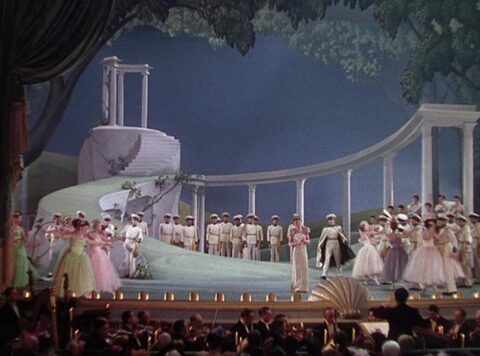
It’s peculiar how restrained and civilised The Climax is. There’s a fine scene where Hohner’s mania really takes hold of him and he hears Angela’s voice coming from everywhere and can’t shut it out, but that’s about as excessive things get until the last ten minutes unless you include an elaborate hypnotism scene involving a circular device, white circles appearing all over Foster and genuinely unnerving closeups of Karloff which is another visual delight. Gale Sondergaard, the “Spider Woman” herself, lurks around as Hohner’s servant, looking both gloomy and sinister, but she also doesn’t have much to do except essentially fill a very predicable role towards the end. Yet one is never quite bored, partly because of how sumptuous the production is. There’s a huge lobby where more and more extras come in and swan around which is a real “showing off” scene, while plush colours are everywhere, except for the black and purple curtains that surround the room where Marcellina is kept in; the contrast is striking and we get a bit of properly morbid Gothic atmosphere for a minute or two, though we could have done with more of this. Still, humour is mostly kept to bickering between Jamilla, in the Biancarolli role, and George Dolenz as her co-star Amato Roselli. The music, mostly by Edward Bond, is decent without ever really rising to the occasion. Themes from the operetta, which is in a familiar Romantic mode, are nicely interpreted into the score proper, but the tone for Angela is a boring waltz that just repeats the same phase. The music which accompanies her entrance on stage in The Magic Voice is Frederick Chopin’s The Minute Waltz with just a few notes changed, and one of Franz Schubert’s Minuet Marches is another theme in the operetta. Some decent dramatic stuff accompanies Hohner at times, but the writers seem to think that turn-of-the-century operettas looked like MGM musicals – though admittedly we’re never given a time and place!
Karloff veers from being typically very good to just average. There are times where, despite the script’s hesitance in such matters, he really evokes his character’s anguish, if still in a quite restrained fashion which is fine. Going for pity rather than fear definitely helps in providing us with sympathy for the character, and but he’s working against a script which fails to even slightly clarify his issues, not to mention a director who doesn’t seem to want to provide much in the way of urgency to the proceedings. Foster is again slightly beguiling and can belt out the notes incredibly, while Turhan Bey, usually cast in exotic roles, is both extremely likeable and interestingly unusual as a rare romantic lead, displaying much boyish enthusiasm and even worship. The Climax, with so much working against it, still manages to just about entertain.
Rating: 









1080p presentation from a 2K scan of the interpositive
Oh no god this film looks magnificent, even if this restoration isn’t taken from an original print. The colours glow vividly, so much so that it’s often over the top but that’s probably the major joy of this film, while there’s considerable detail everywhere you look to. Grain is evenly balanced throughout and blacks certainly haven’t been forgotten, lacking any crush whatsoever. Magnificent.
Brand new audio commentary with Kevin Lyons and Jonathan Rigby
The duo present another quite wonderful audio commentary, even if I respectfully disagree with them when they claim this film to be superior to the 1943 The Phantom Of The Opera; I agree that the humour in the latter is intrusive, but I believe it to have other considerable qualities. They discuss the original play which had a previous and more faithful film version in 1930, the novelisation which specifies the setting, and Lyons was able to dig out even more reviews of the time, one of which bizarrely thinks that Karloff was ill suited for villainous and scary partsm as well as express his personal annoyance at how hypnotism is usually depicted in films. The two are even able to make potted biographies, one of my audio commentary annoyances, interesting. This is the only commentary track which is also on the Scream Factory release; the other two films originally had ones by Tom Weaver.
Trailer
Stills Galleries
DISC TWO
THE BLACK CASTLE [1952]
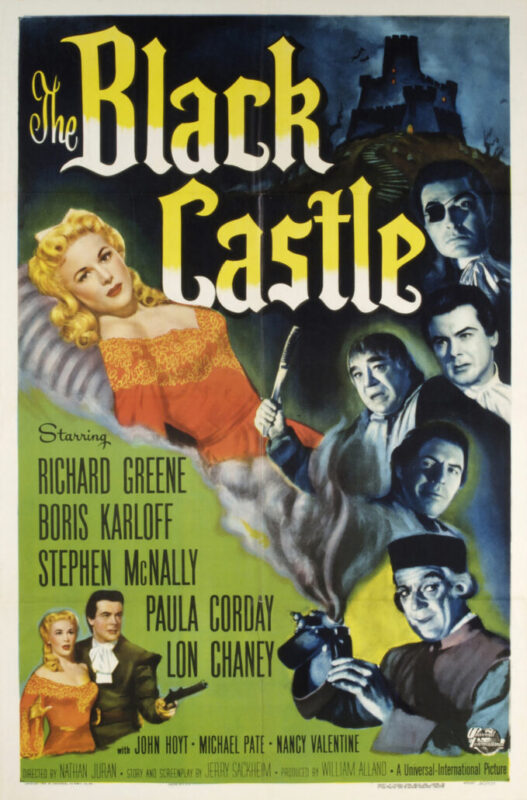
In 19th Century Austria, British officer Sir Ronald Burton travels with his faithful servant Romley to the estate of Count Von Bruno posing as politician Richard Beckett to disguise his identity. He’s been invited to a hunting competition, but is also seeking answers as to what happened to his two friends who disappeared after going to confront Von Bruno about something, and fears the worst. Von Bruno initially welcomes him as a guest though clearly has a sadistic bent which he can’t hide. He doesn’t like Burton’s snooping around and at the hunt he seems to deliberately lead Burton into danger. He also has wife Elga who he treats badly, and soon she and Burton fall in love….
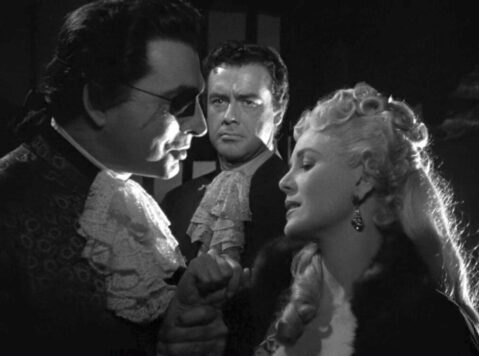
I initially got The Black Castle confused with The Black Room, a very striking 1936 piece where Karloff plays twins [in fact you could almost say he plays a third role in it too] which I watched on TV a couple of years ago and was excited about revisiting it in an infinitely better-looking version than the one Talking Pictures presented. So when it started and I realised it was a very different, disappointment initially dominated my mind before I soon began to really enjoy this later picture in its own right. This pacy picture, the very last of the horrors that Universal made in the traditional way as science fiction was taking over, is easily the most entertaining of the three films in Eureka’s set, even though Karloff only has a supporting role and therefore doesn’t have a great deal of time. He doesn’t have any exchanges with co-star Lon Chaney either, which will disappoint some, though his character does prove to be very important to the plot – unlike the one played by Chaney, who’s relegated to the usual hulking brute studios tended to give him after his rather brief period as Universal’s top horror star. Yet the mixture of rollicking adventure, gloomy Gothic and urgent romance more than holds the attention during the long periods where the two icons are absent from the screen, while the screenplay by Jerry Sackheim structures its story well, opening with an absolute corker of a first scene that immediately grabs the attention, then gradually feeding us more information and, along with the performers, even making us care about the love story which a fair amount of time is spent on.
Universal often recycled music cues for their films, but one still can’t help but chuckle when the opening credits are set to a very familiar piece of music while the castle from The Ghost Of Frankenstein quite obviously is the one seen in the background. Then we get a really opening shot proper as the camera pans from an archway past a statue to a small graveyard, much of this partially shrouded in darkness, into which a man enters and rails against the howling white wolf which we now just about see on the other side of a gate. Then we get into this quite astonishingly creepy and morbid beginning set-up which was virtually re-used in that stunning giallo The Short Night Of Glass Dolls. “It’s almost as if he were alive,” says one of two men in the morgue, looking into the person lying in one of the two coffins they’re about to seal. A disembodied voice emits from the dead man, “Alive? Of course I’m alive. I’m alive Fender. Fender! Fender! Help me. You’ve got to help me. I’m not dead yet,”. We wonder what on earth is really happening before we then flash back in time to Burton visiting a government minister who’s sorted this alias for him so he can embark on what seems to be both an uncovering of secrets and a revenge trip. All we learn about in terms of background is that Von Bruno may have killed two of Burton’s friend, Sterling and Brown. We get a sense of Burton as a very good person when he doesn’t follow the suggestion of the coach driver that he make his servant walk, before they stop by a pub named The Green Man to stay the night. The manager says he hasn’t heard of Sterling and Brown, but he’s clearly lying. Then, when Burton gets a villager named Fender to sit with them, in burst two of Von Bruno’s men to try to take over their table. However, Burton’s adept with a sword, so easily disarms them in a nice little scene, though it’s also a bit misleading, because it suggests that a sword duel between hero and villain will take place at the end.
Still, we’re properly intrigued as we finally get to the castle and Burton can’t wait to begin looking around. He’s caught by Elga followed by Von Bruno looking in a cupboard “Ever since I was a school boy cupboards have always fascinated me” is his lame excuse, but he gets away with it for now. There are secret passageways, a dungeon, an indoor portcullis that quickly comes down if you step on a particular stone, and a crocodile pit. Karloff’s character is Dr. Meissen the castle physician, and right away we don’t know if we like him or not, though it’s obvious that Chaney’s mute beast Gargon we’re just intended to fear. Von Bruno has brought a black leopard all the way from Africa which he and Gargon rile up by whipping its cage. The following day, Von Bruno arranges it that he and Burton are hunting partners, then ensures that Burton comes face to face with the leopard, cue for one of those always amusing scenes where people fight dead or toy animals and move them about to make it look like it’s moving by itself. Von Bruno eventually shoots the leopard but Burton gets the praise and the prize. He’s fascinated by an African pendant that Elga wears and takes it off her while kissing her, though we don’t see or hear anything about it afterwards. The two fall genuinely in love, though this was 1952 and unfaithful wives, even when the unfaithfulness only seems to be kisses, usually had to be punished. Therefore when Von Bruno tells Gargon that he can do what he wants with her, we expect a hint of sexual assault followed by murder – yet we next see her in a dungeon room looking absolutely fine except for a bruise on one of her cheeks. Were there drastic script changes here? It’s odd because the screenplay is otherwise quite well thought through and things follow on other things pretty smoothly. Burton and Von Bruno do a lot of skating around issues, but soon things get really serious. However, could there be a way for our couple to escape?
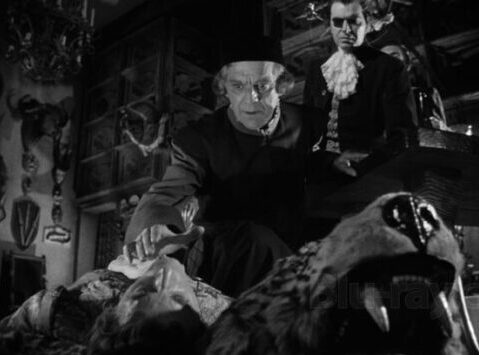
One senses that we could be in for some The Most Dangerous Game-type stuff with Von Bruno and his men hunting our couple through the studio forest, but instead we get a final reel where are hero and heroine are inactive but we, the viewer, are on the edge of our seats even though we must know that the way these film generally were dictates that they will surely survive – won’t they? Shots from inside the coffin while it’s shut would have things even more intense, but it’s still pretty well handled up to the rather sudden conclusion. Even the lead-up to this section is strong, so much so that we don’t really need one of the characters to mention Romeo and Juliet as the two take this drug that will make them seem dead; we make the connection anyway and genuinely care about these two people. Richard Greene and Rita Corday do display some chemistry too. Of course we do eventually get the entire back story and it involves Africa with a seemingly pro-colonialist slant that probably wouldn’t be seen in a film today and which may make some viewers grimace, though we also have Elga expressing her dislike of the way animals are imported just to be hunted, quite unusual for the time, at least in something like this. There’s another, much more minor, female character in the form of Theresa who’s no doubt just one of many women Von Bruno messes around with but seems to be bafflingly in love with him. But then again Stephen McNally has good presence as the Count and, while Greene is just all surface, both performers are good enough to make the many scenes where the two just talk, often hiding things, just as fun as the thrill and horror ingredients.
Karloff and Chaney got get great entrances, Karloff treating and hurting a patient while discussing how the Romans used to have endurance competitions, Chaney walking menacingly into the camera. I always feel sad when I see Chaney in one of these many similar parts that just require him to be ugly and intimidating with little room for nuance, and his death scene is one of those where the person killed seems awfully clumsy, but at least Karloff plays a person who virtually shapes the later parts of the take and also gets to act juicily ambiguous; that voice sounds quite gentle here but some of those looks are still unsettling. When Meissen seems to reveal himself as one of the good guys but then betrays them, we curiously don’t hate him. The music score is comprised of cues from the likes of Son Of Frankenstein and The Wolfman; they fit in quite well but if you watch those films quite often they can’t help but stick out. The director is the extremely erratic Nathan Juran, in his debut feature. Largely avoiding close-ups, he stages dialogue scenes with good character positioning and deep focus photographic depth that anticipates Roger Corman; in fact the whole film may have influence the Corman/Poes. Look out also for some very skillful integration of crocodile pit footage from another film, including a terrific shot of the water’s ripples reflecting on a ledge. The Black Castle makes a good effort to please throughout.
Rating: 









SPECIAL FEATURES
1080p presentation from A 2K scan of fine grain film elements
These may be essentially lesser films, but Universal seem to be treating them with just as much respect as their classics in terms of their restorations. This one really showcases Irvin Glassberg’s cinematography with all those shadows looking as black as possible, and gives us plenty of texture in the costumes too.
Brand new audio commentary track on The Black Castle with author Stephen Jones and author / critic Kim Newman
Newman and Lyons take over for the third track; as usual they’re just as fun to listen to; Newman might be the most knowledgeable of all three, he and Lyons will go off a bit more on tangents. They refer a lot here to a film called Strange Door to which this is a similar follow up [much like The Phantom Of The Opera and The Climax]; Jones wishes the romantic couple was the one in Strange Door and Newman makes a case for producer William Alland being a very major figure in ’50s horror and science fiction, as well as telling that the film’s shock eye reveal was copied from The Secret Of The Chateau.
Trailer
Stills Galleries
SET SPECIAL FEATURES
Limited Edition slipcase [2000 copies]
Optional English SDH
A limited edition collector’s booklet featuring new writing by Karloff expert Stephen Jacobs (author of Boris Karloff: More Than a Monster) [2000 copies]
The three films range in quality, but they’re diverse and give a good indication of Karloff’s considerable range and acting ability, while the set could virtually act as reference material for restorations of vintage movies. Recommended!


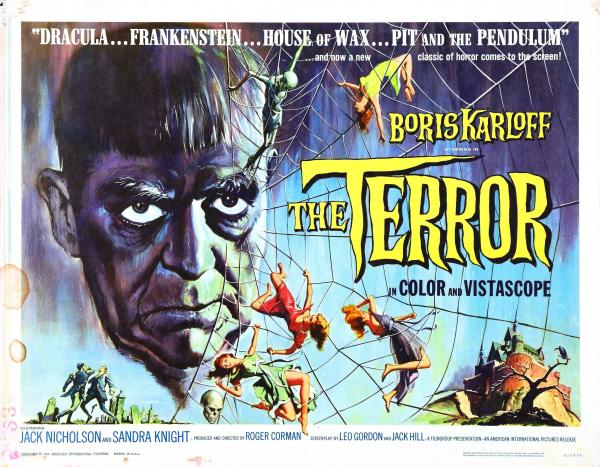

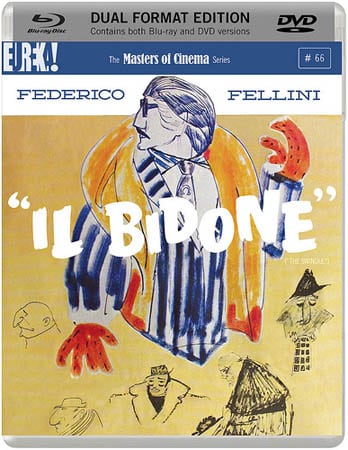
Be the first to comment